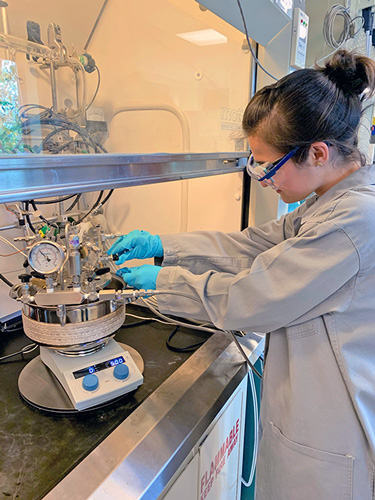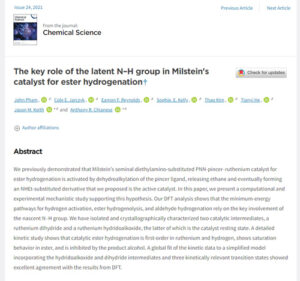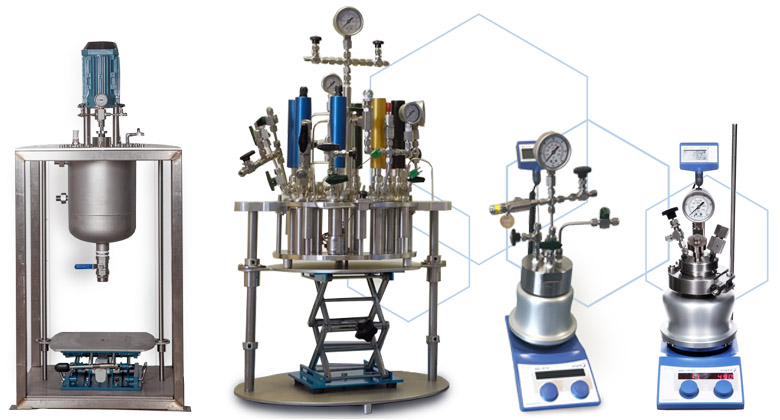Prof. Anthony Chianese from Colgate University (NY, USA) has reported that the university chemistry department have used kinetic data taken from the Asynt Multicell 10-position high pressure laboratory reactor in three recently published papers. One of these papers, “The Key Role of the Latent N-H Group in Milstein’s Catalyst for Ester Hydrogenation” includes the teams’ characterisation of the mechanisms of Milstein’s catalysts and succeeded in developing a greater understanding of the reactivity of these vital catalysts in ester hydrogenation.
Named after Prof. David Milstein, the highly esteemed chemist who discovered them, these catalysts are used within a multitude of basic processes within bulk chemical production. Development of these catalytic processes is therefore a significant potential area of improvement for economical and sustainable growth of the chemical industry. Milstein catalysts utilise transition-metal complexes consisting of pincer ligands to activate a range of covalent bonds.
Chemists at Colgate University initially determined that ruthenium complexes containing PNN-pincer ligands are initially inactive, and upon dehydroalkylation of the pincer ligand, form the active NHEt-substituted derivative, with ethane or propane as a side product. This showed that the latent N-H groups generated were key to the catalytic activity, leading to the discovery of the most active catalyst for ester hydrogenation known to date.
In a separate study, through experiments on PNN- and PNP- ruthenium pincer complexes, they were able to discover that with isopropyl alcohol as the solvent, low catalyst loadings could be used to achieve highly branch selective hydrogenolysis of epoxides without the use of a strong base. They were able to produce high yields of the branched alcohol with minimal catalyst loading from the PNP-pincer complex Ru-MACHO-BH, a commercially available catalyst, much cheaper than alternative catalysts tested.
Hydrogenation reactions are typically carried out under pressure, and therefore require a suitable high-pressure vessel. As the chemists at Colgate University were carrying out a variety of hydrogenations, their vessel had to be safe to operate at various pressures, ranging from 10 to 30 bar.

Image: student, Mina Head, from the Chianese group – with the Asynt Multicell
The Asynt Multicell used by Prof. Chianese’s team had also been customised specifically for sampling – to aid the application of catalysis.
This Asynt Multicell allows 10 parallel reactions at high pressure up to 50 or 100 bar, and temperatures up to 350 oC. As standard, safety features include a pressure relief valve and gauge however further optional safety measures such as burst disks are available. The Asynt Multicell are widely customisable, with sampling, charging, and individual vessel pressures possible for further screening capabilities. Heating is via standard laboratory hotplate and temperature coupling is enabled by the thermowell to control the temperature of the reaction within the vessels.
See full details of the specified Multicell reactor here: www.asynt.com/press-releases/custom-parallel-hpr-evaluation/
The paper referenced above:
Pham, J.; Jarczyk, C. E.; Reynolds, E. F.; Kelly, S. E.; Kim, T.; He, T.; Keith, J. M.;* Chianese, A. R.* “The Key Role of the Latent N-H Group in Milstein’s Catalyst for Ester Hydrogenation,” Chem. Sci., 2021, 12, 8477-8492. https://doi.org/10.1039/D1SC00703C
The further papers mentioned:
- Kirlin, F. L., Borden, O. J., Head, M. C., Kelly, S. E., Chianese, A. R.* “Epoxide Hydrogenolysis Catalyzed by Ruthenium PNN and PNP Pincer Complexes,” Organometallics, 2022, 41, 1025-1033. https://doi.org/10.1021/acs.organomet.2c00068
- He, T.; Buttner, J. C.; Reynolds, E. F.; Pham, J.; Malek, J. C.; Keith, J. M.;* Chianese, A. R.* “Dehydroalkylative Activation of CNN- and PNN-Pincer Ruthenium Catalysts for Ester Hydrogenation,” J. Am. Chem. Soc., 2019, 141, 17404-17413. https://pubs.acs.org/doi/10.1021/jacs.9b09326
For further information on Professor Anthony Chianese: https://www.colgate.edu/about/directory/achianese
Colgate University chemistry department:
https://www.colgate.edu/academics/departments-programs/department-chemistry
Would you like to know more about our complete range of single and multi-position pressure reactors?
Find out how our perfectly engineered pressure reactors can help you achieve the results you want. We offer some handy standardised specifications for those requiring something straight forward, but we’re also able to customise these or provide a fully bespoke solution. Whether that’s a 50 mL single pressure reactor or a room-sized pressure system, our experts can help. Take a look at some of the options available by clicking the image or the link below, or drop us an email to [email protected].
Visit: https://www.asynt.com/products/pressure-reactors/multi-position-high-pressure/
Reference: ASY-EV-165






